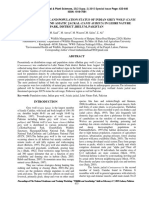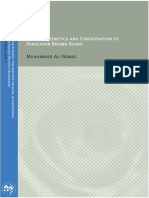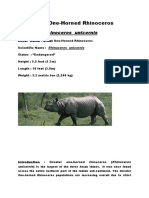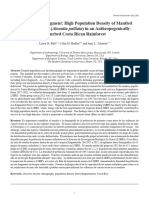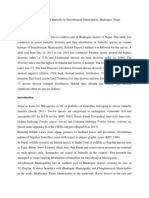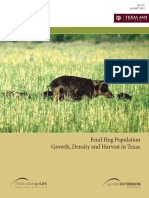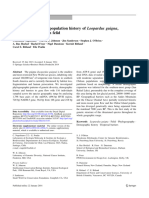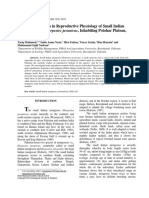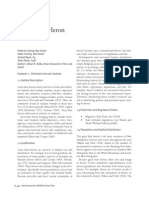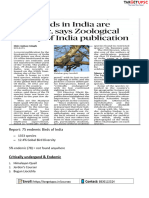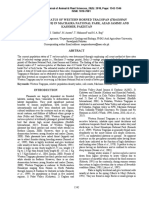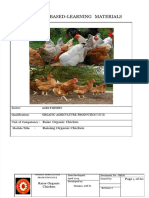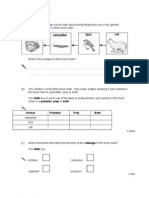Western Tragopan
Western Tragopan
Uploaded by
Anirudh AcharyaCopyright:
Available Formats
Western Tragopan
Western Tragopan
Uploaded by
Anirudh AcharyaOriginal Description:
Copyright
Available Formats
Share this document
Did you find this document useful?
Is this content inappropriate?
Copyright:
Available Formats
Western Tragopan
Western Tragopan
Uploaded by
Anirudh AcharyaCopyright:
Available Formats
Western Tragopan Tragopan melanocephalus
Justification This species is classified as Vulnerable because its small and sparsely distributed population is declining and becoming increasingly fragmented in the face of continuing forest loss and degradation throughout its restricted range. Recent estimates suggest the population size may be smaller than previously thought, in light of which the species may warrant uplisting to Endangered. Taxonomic source(s) Sibley, C. G.; Monroe, B. L. 1990. Distribution and taxonomy of birds of the world. Yale University Press, New Haven, USA. Identification Male 68-73 cm, female 60 cm. Typical tragopan, with orange to red collar, red facial skin and white-spotted, black belly.Similar spp. Confusion could arise with Satyr Tragopan T. satyra in the south-east of its range, although recent surveys suggest that the two species only occur sympatrically in one area of Uttarakhand where they occur in a single catchment. Male differs from that species primarily by red facial skin and mostly black base-colour of lower breast to vent, female has a noticeably duller and greyer base-colour to upperparts and, in particular, underparts. Voice Territorial call, nasal, wailing khuwaah, repeated 7-15 times during the breeding season. Abrupt waa waa waa when agitated.
Map Data
- Terms of Use
Distribution and population Tragopan melanocephalus has a disjunct distribution in the western Himalayas (A. Rahmani in litt. 2012), occurring from Indus-Kohistan district, north Pakistan, east through Kashmir and Himachal Pradesh to Uttarakhand, north-westIndia (BirdLife International 2001). Although historically described as scarce and local, a mid-1980s population estimate of 1,600-4,800 birds was revised in the mid-1990s to c.5,000 birds following the discovery of several significant populations in north Pakistan, the largest of which (tentatively estimated at 325 pairs) is in Palas Valley. Recent reports of additional populations in Azad Jammu and Kashmir (Pakistan) and Himachal Pradesh (India) as well as new data confirming its occurrence in Uttarakhand suggest that the population may require further upward revision in the future (K. Ramesh in litt. 2007). However, there is also recent evidence suggesting that call count methodologies overestimate true population densities as many calls may refer to unpaired males and hence simply doubling the number of calling birds is unlikely to accurately reflect the size of a breeding population. Along with declines since the 1990s, this may mean the population size is significantly lower than 5,000 individuals. The prevalence of threats also implies that the population is now lower than this, and it has been suggested that there are now only 2,500-3,500 individuals remaining in the wild (S. Pandey per A. Rahmani in litt. 2012); however, surveys should be carried out to confirm this. Population justification A population estimate of at least 5,000 individuals is derived from Gaston et al. (1981b) and McGowan and Garson (1995). This is roughly equivalent to 3,300 mature individuals. Recent reports of additional populations in Azad Jammu and Kashmir, Pakistan and Himachal Pradesh may lead to an increase in the estimated global population size in the future, although conversely it has been suggested that the world population in the wild has been reduced to 2,500-3,500 individuals (S. Pandey per A. Rahmani in litt. 2012), prompting the need for wider surveys. Trend justification The species's population is likely to be in decline given the combined threats of trapping, hunting, disturbance by humans and livestock, and habitat degradation (F. Buner in litt. 2012), but this decline has not been quantified and is not thought to be particularly severe,
thus the rate of decline is suspected to be moderate. Ecology During the breeding season (April-June), it inhabits little-disturbed temperate coniferous and deciduous forests, from 2,400-3,600 m. In winter, it makes very local altitudinal or lateral movements, to grassy or shrubby gulleys with less snow cover, between 1,750 m and 3,000 m. Threats Threats to the species are thought to have intensified in recent years (A. Rahmani in litt. 2012). Habitat degradation and fragmentation through subsistence farming, browsing of understorey shrubs by livestock, tree-lopping for animal fodder and fuelwood-collection are the main threats. Disturbance by grazers and particularly collectors of edible fungi and medicinal plants may seriously interfere with nesting. Hunting and trapping for its meat (especially in winter) and its decorative plumage pose additional threats, throughout Pakistan (R. Nawaz in litt. 2004), Himachal Pradesh and Chamba (India). Conservation actions underway CITES Appendix I. It is afforded legal protection in both India and Pakistan. It occurs in national parks in both Pakistan and India, as well as in 10 wildlife sanctuaries. Discovery of the large Palas population triggered a major conservation initiative in the region for which this bird is the flagship species. A galliform monitoring and conservation project within the valley ended in 2010 (F. Buner in litt. 2012). Surveys have been conducted recently across most of its presumed range in Pakistan, and in Himachal Pradesh, where, in 2005, c.3,000 forest guards and officers were involved in a coordinated week long state-wide survey (L. Mohan in litt. 2007). It is currently the subject of a conservation breeding programme in Himachal Pradesh (J. Corder in litt. 2004), involving fewer than 10 pairs, which produce fewer than three broods each year (F. Buner in litt. 2012), with the long-term possibility of future releases of parent-reared offspring to augment/restock local wild populations (K. Ramesh in litt. 2007). Awareness-raising activities, field officer training and population surveys were conducted recently in Salkhala Game Reserve, Pakistan (Awan 2010). Surveys in Himachal Pradesh were initiated by the state wildlife department in 2011, and state-wide surveys were started there in 2012 (F. Buner in litt. 2012). Conservation actions proposed Conduct surveys to increase knowledge of its current distribution and abundance, especially in Pakistani and Indian Kashmir, where very few data exist (F. Buner in litt. 2012). Initiate public awareness campaigns in and around known sites, highlighting its flagship status for the conservation of moist temperate forests and other pheasant species. Develop monitoring methods and then monitor key populations regularly. Study the ecology of radio-tagged birds (A. Rahmani in litt. 2012). Improve management in key protected areas. Extend the boundaries of Salkhala Game Reserve and implement a monitoring programme (Awan 2010).
You might also like
- The Ugly DucklingDocument5 pagesThe Ugly DucklingSheen aballeNo ratings yet
- Birds of Sri Lanka - 2000Document146 pagesBirds of Sri Lanka - 2000Edson França Rodrigues100% (2)
- Rufous Headed HornbillDocument2 pagesRufous Headed HornbillShaina Marie GaroNo ratings yet
- Distribution Range and Population Status of Indian Grey WolfDocument8 pagesDistribution Range and Population Status of Indian Grey WolfMohammad SalimNo ratings yet
- Contribution To The Red List of Pakistan: A Case Study Of: Delphinium Nordhagenii (Ranunculaceae)Document5 pagesContribution To The Red List of Pakistan: A Case Study Of: Delphinium Nordhagenii (Ranunculaceae)Haidar AliNo ratings yet
- Grey FrancolinDocument7 pagesGrey FrancolinsyedqasimzaidiNo ratings yet
- A Landscape Approach in Conserving Large Mammals: A Case Study From Western Terai, NepalDocument12 pagesA Landscape Approach in Conserving Large Mammals: A Case Study From Western Terai, NepalAjaya NagarkotiNo ratings yet
- PH Dthesis NawazDocument224 pagesPH Dthesis Nawazmuhammad ali ammer officialNo ratings yet
- Great One-Horned RhinocerosDocument6 pagesGreat One-Horned Rhinocerosshreyansh shresthaNo ratings yet
- Shannon Wiener Diversity Index CalculationDocument6 pagesShannon Wiener Diversity Index CalculationsinghadkNo ratings yet
- Critically Endangered BookletDocument26 pagesCritically Endangered BookletAbhilashMaNo ratings yet
- Gutturosa: by Driving Long-Distance TransectsDocument6 pagesGutturosa: by Driving Long-Distance TransectsJohn BallesterosNo ratings yet
- Assessment of Humancarnivore Conflict in Chitral PakistanDocument5 pagesAssessment of Humancarnivore Conflict in Chitral PakistanKhurram Saeed QaziNo ratings yet
- Olah Macaw Genetics Proposal 2009Document10 pagesOlah Macaw Genetics Proposal 2009Jeff CremerNo ratings yet
- Altitudinal Distribution of Skinks Along Cantubias Ridge of Mt. Pangasugan, Baybay, LeyteDocument20 pagesAltitudinal Distribution of Skinks Along Cantubias Ridge of Mt. Pangasugan, Baybay, LeyteLitlen DaparNo ratings yet
- Wildlife Biology - 2011 - Frary - Density and Distribution of A Colonizing Front of The American Black Bear UrsusDocument13 pagesWildlife Biology - 2011 - Frary - Density and Distribution of A Colonizing Front of The American Black Bear UrsusJesse SmerNo ratings yet
- Kuno Birds by T. RameshDocument5 pagesKuno Birds by T. RameshTharmalingam RameshNo ratings yet
- Mongolian Gobi Supports Largest Population of Khulan and Goitered GazellesDocument9 pagesMongolian Gobi Supports Largest Population of Khulan and Goitered GazellesTsermaa ChoisurenNo ratings yet
- Bolt-Et-Al Primate-Conservation 2022 240608 083913Document9 pagesBolt-Et-Al Primate-Conservation 2022 240608 083913Ernesto Quirós JiménezNo ratings yet
- Diversity and Distribution of Butterfly in Suryabinayak MunicipalityDocument8 pagesDiversity and Distribution of Butterfly in Suryabinayak MunicipalitySanej Prasad SuwalNo ratings yet
- Diversity Ecological Feature and ConservDocument16 pagesDiversity Ecological Feature and ConservAna JohnyNo ratings yet
- Relative Abundance and Distribution of Black-And-wDocument10 pagesRelative Abundance and Distribution of Black-And-wMifta JemalNo ratings yet
- Mitochondrial Divergence Between Western and Eastern Great Bustards Implications For Conservation and Species StatusDocument12 pagesMitochondrial Divergence Between Western and Eastern Great Bustards Implications For Conservation and Species StatusTuvshin UNo ratings yet
- Review of LiteratureDocument11 pagesReview of LiteratureZahid NabiNo ratings yet
- Western Ringtail Possum Year 3 ScorecardDocument16 pagesWestern Ringtail Possum Year 3 Scorecardlily.huang3No ratings yet
- ESP 472 Feral Hog Population Growth Density Harvest in TexasDocument8 pagesESP 472 Feral Hog Population Growth Density Harvest in TexasOreillerNo ratings yet
- Distribution of Indian Flying Foxpteropus Giganteus Brünnich, 1782Document4 pagesDistribution of Indian Flying Foxpteropus Giganteus Brünnich, 1782Mohammad SalimNo ratings yet
- Jahangger Et Al We JournalDocument11 pagesJahangger Et Al We JournalJahangeer KhushikhlaqNo ratings yet
- (Elephas Maximus) During The First Wet Season at TheDocument44 pages(Elephas Maximus) During The First Wet Season at TheAvinash Krishnan100% (1)
- Bird Species SharavathyDocument5 pagesBird Species SharavathyguddadabhoothaNo ratings yet
- Feral Hog Population Growth Density and Harvest in TexasDocument8 pagesFeral Hog Population Growth Density and Harvest in TexasTAMU Wildlife and Fisheries ExtensionNo ratings yet
- 2023 - Pangolin Kohat Paper JAPSDocument7 pages2023 - Pangolin Kohat Paper JAPSfarazakrimNo ratings yet
- Diversity Abundance and Composition of Non Human PrimatesDocument6 pagesDiversity Abundance and Composition of Non Human PrimatesJournal of Environment and Bio-SciencesNo ratings yet
- Serosurvey For Selected Viral Infections in Free-Ranging Jaguars (Panthera Onca) and Domestic Carnivores in Brazilian Cerrado, Pantanal, and AmazonDocument12 pagesSerosurvey For Selected Viral Infections in Free-Ranging Jaguars (Panthera Onca) and Domestic Carnivores in Brazilian Cerrado, Pantanal, and Amazonapi-253379995No ratings yet
- UntitledDocument21 pagesUntitledJihad BioNo ratings yet
- Azevedo & Murray (2007) Biol. Conserv PDFDocument12 pagesAzevedo & Murray (2007) Biol. Conserv PDFDennis MurrayNo ratings yet
- Mammalogy Portfolio 2Document15 pagesMammalogy Portfolio 2api-349076072No ratings yet
- Guizoni Et Al 2005 - Spatial Explicit Dynamics of A Amazon RodentDocument6 pagesGuizoni Et Al 2005 - Spatial Explicit Dynamics of A Amazon RodentViviane LaymeNo ratings yet
- 1C - Rarity in Antpittas - Territory Size and Population Density of Five GrallariaDocument11 pages1C - Rarity in Antpittas - Territory Size and Population Density of Five GrallariaJuan GarciaNo ratings yet
- Long-Term Monitoring of Yellow-Naped Amazons (Amazona Auropalliata) in Costa Rica Breeding Biology, Duetting, and The Negative Impact of PoachingDocument10 pagesLong-Term Monitoring of Yellow-Naped Amazons (Amazona Auropalliata) in Costa Rica Breeding Biology, Duetting, and The Negative Impact of Poachingmgsz3id5lNo ratings yet
- Art 25Document6 pagesArt 25D. L.C.No ratings yet
- Zschokke Et Al Biological Conservation 2011Document8 pagesZschokke Et Al Biological Conservation 2011josianelarose08No ratings yet
- Estudio de Jaguar Poblacion InglesDocument7 pagesEstudio de Jaguar Poblacion Inglesestefani tejada moreanoNo ratings yet
- Napolitano Et Al 2014 - Phylogeo GuignaDocument23 pagesNapolitano Et Al 2014 - Phylogeo GuignaTerreno CicloFaunaNo ratings yet
- 2014-Diversity of Wild Mammalian Fauna of Chenab Riverine Forest, Punjab, PakistanDocument6 pages2014-Diversity of Wild Mammalian Fauna of Chenab Riverine Forest, Punjab, PakistanMuhammadUmairNo ratings yet
- 1263-1270 (7) PJZ-1781-14 .Docx 9-7-15 (160495)Document8 pages1263-1270 (7) PJZ-1781-14 .Docx 9-7-15 (160495)Faraz AkrimNo ratings yet
- Great Blue HeronDocument4 pagesGreat Blue HeronjxmackNo ratings yet
- Rapid Population Declines of Himalayan Griffon Gyps Himalayensis in Upper Mustang, NepalDocument9 pagesRapid Population Declines of Himalayan Griffon Gyps Himalayensis in Upper Mustang, NepalAvi HamalNo ratings yet
- PerezCarussi2017_Spatial segregation among pampas deer and exotic ungulatesDocument9 pagesPerezCarussi2017_Spatial segregation among pampas deer and exotic ungulatesHebe CuccaroNo ratings yet
- Target 140 Lecture 7Document15 pagesTarget 140 Lecture 7vanshita kumariNo ratings yet
- WLF 448 - Research Paper Draft 2Document10 pagesWLF 448 - Research Paper Draft 2Anonymous 2YErRACLRKNo ratings yet
- Threats Facing Carnivores: Habitat FragmentationDocument2 pagesThreats Facing Carnivores: Habitat Fragmentationmamillapalli sri harshaNo ratings yet
- Birds of PalawanDocument24 pagesBirds of PalawanAaron WoodardNo ratings yet
- Ardern and Lambert 1997Document8 pagesArdern and Lambert 1997Tyler KieftNo ratings yet
- Almiron Et Al 2011 A Failed Swallowing Attempt Upon A Crab-Eating FoxDocument4 pagesAlmiron Et Al 2011 A Failed Swallowing Attempt Upon A Crab-Eating FoxEverton MirandaNo ratings yet
- 2010 BrodersetalJWMDocument12 pages2010 BrodersetalJWMUmair AneesNo ratings yet
- Habitat Preferences and Roost Site Selection of Rhinopoma HardwickiiDocument4 pagesHabitat Preferences and Roost Site Selection of Rhinopoma HardwickiiMohammad SalimNo ratings yet
- Applied-Avifauna of Chandrampalli Dam - ManjunathDocument10 pagesApplied-Avifauna of Chandrampalli Dam - ManjunathImpact JournalsNo ratings yet
- AnimalDocument5 pagesAnimalrodrigokine777No ratings yet
- Improving Livestock Out-Put of Small Holder Mountain Communties in The HindukushDocument27 pagesImproving Livestock Out-Put of Small Holder Mountain Communties in The Hindukushabubakrabdelhab hamdNo ratings yet
- Population Dynamics of Ground Dwelling Spider Genera Among Mustard Crop - JBESDocument10 pagesPopulation Dynamics of Ground Dwelling Spider Genera Among Mustard Crop - JBESInternational Network For Natural SciencesNo ratings yet
- Bioelectricity: Section 1 - Make PlansDocument71 pagesBioelectricity: Section 1 - Make PlansAnirudh AcharyaNo ratings yet
- VBZ 2009 0035Document8 pagesVBZ 2009 0035Anirudh AcharyaNo ratings yet
- Population and Parity Levels of Aedes Aegypti Collected in TucsonDocument9 pagesPopulation and Parity Levels of Aedes Aegypti Collected in TucsonAnirudh AcharyaNo ratings yet
- Trend of Malaria in KarnatakaDocument8 pagesTrend of Malaria in KarnatakaAnirudh AcharyaNo ratings yet
- Guidelines: Food and Agriculture Organization of The United NationsDocument16 pagesGuidelines: Food and Agriculture Organization of The United NationsAnirudh AcharyaNo ratings yet
- Chapter 3 Recombinant DNA TechnologyDocument39 pagesChapter 3 Recombinant DNA TechnologyAnirudh Acharya50% (2)
- Pouch and Will Develop Into The Anterior Pituitary orDocument130 pagesPouch and Will Develop Into The Anterior Pituitary orAnirudh AcharyaNo ratings yet
- CephalopodDocument14 pagesCephalopodAnirudh AcharyaNo ratings yet
- Hypothalamus and Its Hormones, Hormones of The Pituitary GlandDocument28 pagesHypothalamus and Its Hormones, Hormones of The Pituitary GlandAnirudh AcharyaNo ratings yet
- PomcDocument8 pagesPomcAnirudh AcharyaNo ratings yet
- SI No. Date Experiments Page NoDocument1 pageSI No. Date Experiments Page NoAnirudh AcharyaNo ratings yet
- Ames TestDocument16 pagesAmes TestAnirudh AcharyaNo ratings yet
- Neuroendocrine of CrustaceaDocument29 pagesNeuroendocrine of CrustaceaAnirudh Acharya100% (1)
- Presented By:: Anirudh R. Acharya, M.SC - II Semester, Department of Zoology, University of MysoreDocument38 pagesPresented By:: Anirudh R. Acharya, M.SC - II Semester, Department of Zoology, University of MysoreAnirudh AcharyaNo ratings yet
- Pests of CerealsDocument22 pagesPests of CerealsAnirudh AcharyaNo ratings yet
- Coleur English StandardDocument58 pagesColeur English Standardadel malikNo ratings yet
- Citizen Bird Scenes From Bird-Life in Plain English For Beginners by Coues, Elliott, 1842-1899Document251 pagesCitizen Bird Scenes From Bird-Life in Plain English For Beginners by Coues, Elliott, 1842-1899Gutenberg.orgNo ratings yet
- Sparrow Cheatsheet AllDocument4 pagesSparrow Cheatsheet AllJoannaRicoHernándezNo ratings yet
- The Ugly DucklingDocument2 pagesThe Ugly DucklingJenica Mariel GabaisenNo ratings yet
- Bird Feeding GuideDocument2 pagesBird Feeding GuideSYED RAIYAN HOSSAINNo ratings yet
- 00 Penguin Chick WorkbookDocument10 pages00 Penguin Chick Workbookapi-546418402No ratings yet
- The Shaggy Brown Chicken and Other Poems For Children (And For Chickens of All Ages) by Kris Lanot LacabaDocument10 pagesThe Shaggy Brown Chicken and Other Poems For Children (And For Chickens of All Ages) by Kris Lanot LacabaCharlene De AsisNo ratings yet
- Washington Nisqually National Wildlife Refuge Educator's GuideDocument152 pagesWashington Nisqually National Wildlife Refuge Educator's GuideFree Rain Garden ManualsNo ratings yet
- BirdLife Data Zone EBA 046 Southern Central AndesDocument2 pagesBirdLife Data Zone EBA 046 Southern Central AndesDavid FigueroaNo ratings yet
- (1900) The Game Birds and Wild Fowl of The British IslesDocument594 pages(1900) The Game Birds and Wild Fowl of The British IslesHerbert Hillary Booker 2nd100% (2)
- The Cactus BirdDocument7 pagesThe Cactus BirdManuel PintoNo ratings yet
- Usfws-R6-Eagle-Nest-Survey Protocol-Recommendations-Wind-Energy-Projects-V3-2021Document6 pagesUsfws-R6-Eagle-Nest-Survey Protocol-Recommendations-Wind-Energy-Projects-V3-2021royaxe1980No ratings yet
- HW 1Document4 pagesHW 1Mohamed JafferNo ratings yet
- Ilovepdf MergedDocument3 pagesIlovepdf MergedDimas Hakri LenaldiNo ratings yet
- Do Roosters Have A Penis - Cackle HatcheryDocument16 pagesDo Roosters Have A Penis - Cackle HatcheryMaddy SjiicroNo ratings yet
- Body Weight &egg Weight ChartDocument3 pagesBody Weight &egg Weight ChartRAMESHKUMAR KARUPUNo ratings yet
- Mingoa - Raising Organic ChickenDocument70 pagesMingoa - Raising Organic Chickenjeffmingoa88No ratings yet
- Breeds and Types of PoultryDocument22 pagesBreeds and Types of PoultryTenika RodriguezNo ratings yet
- Nature Walk (A) Some Children Draw ADocument6 pagesNature Walk (A) Some Children Draw Aktminett1434No ratings yet
- Chakewa BirdDocument5 pagesChakewa BirdkmcemisNo ratings yet
- Cheklist of Karnataka BirdsDocument30 pagesCheklist of Karnataka BirdsShilpaNo ratings yet
- Unit 1 Animals: Objective QuestionsDocument11 pagesUnit 1 Animals: Objective QuestionsharrazNo ratings yet
- Essay On The Arctic TernDocument4 pagesEssay On The Arctic TernaftabNo ratings yet
- Breeding Recessive Mutation Zebra FinchesDocument3 pagesBreeding Recessive Mutation Zebra Finchesrstrman100% (1)
- Root Faction Selector v1.0Document20 pagesRoot Faction Selector v1.0anaya.cuellar.andresNo ratings yet
- Bird MigrationDocument9 pagesBird MigrationsmokerNo ratings yet
- Poultry Guide Part 1Document2 pagesPoultry Guide Part 1Polski BalucayNo ratings yet
- DVC-GBW Winter 2022 NewsletterDocument8 pagesDVC-GBW Winter 2022 NewsletterValeria KremserNo ratings yet



